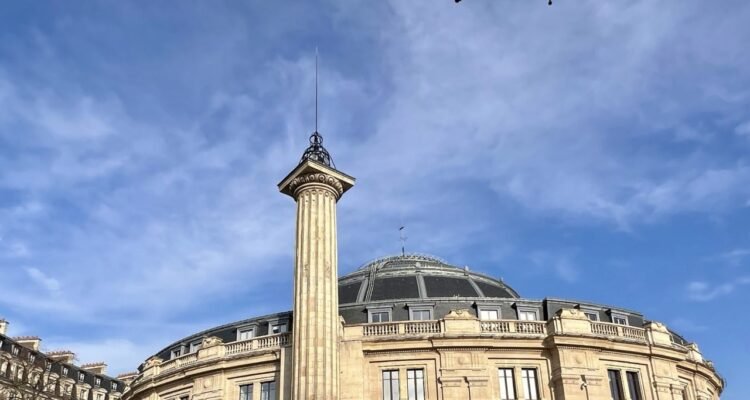Hidden in Plain Sight: Lesser-Known Paris Monuments
The quiet legends, the stone whispers, the beauty you’ve walked past a hundred times.
Paris is a city of spectacle—but its true magic? That lives in the shadows. In the corners you almost missed. Behind cafés, between metro stops, or above your line of sight, where monuments to mystery, intellect, and strangeness quietly assert their presence. These aren’t the headliners of guidebooks, but their stories are just as rich. The Socialites invite you on a sculptural treasure hunt through the capital—where every stone has a secret.
The Medici Column (1er)
Tucked behind the hulking Bourse de Commerce, this 31-meter column soars skyward with no explanation—no statue, no inscription, no fanfare. Commissioned in 1575 by Catherine de Medici, it was designed as an astrological observatory for her court magician, Cosimo Ruggieri. Today, it remains locked, enigmatic, and gloriously unnecessary.
Find it: Rue de Viarmes, beside the Bourse de Commerce
Le Mur des Je t’aime (18e)
Yes, it’s been discovered by Instagram, but it’s still overlooked as a work of conceptual poetry. Nestled in a quiet garden near Place des Abbesses, this wall features “I love you” scrawled in over 250 languages. Created by artists Frédéric Baron and Claire Kito, it’s not about romance—it’s about peace through polyphony.
Find it: Square Jehan Rictus, Place des Abbesses
Arènes de Lutèce (5e)
Step through a sleepy gate in the Latin Quarter and you’re suddenly in ancient Rome. This preserved 1st-century amphitheater once held 15,000 cheering Lutetians. Today, it hosts pétanque matches, students lounging on stone steps, and the occasional confused tourist wondering how the hell they missed this in the brochure.
Find it: 49 Rue Monge or Passage des Arènes
La Fontaine Médicis (6e)
Sure, everyone strolls the Jardin du Luxembourg, but many miss this melancholic marvel near the back of the park. Originally built in the 1630s for Marie de Medici, this Baroque fountain is a cinematic composition of nymphs, moss, and myth. It’s the kind of place where time sighs.
Find it: Jardin du Luxembourg, near the eastern edge (Rue de Médicis)
Saint-Séverin’s Twisted Pillar (5e)
This Gothic church near the Seine hides one of Paris’s strangest architectural gestures: a swirling, spiral column in the ambulatory, unlike anything else in the city. It looks like it’s dancing. Most visitors never notice it—they’re too focused on stained glass or the organ’s roar.
Find it: 3 Rue des Prêtres Saint-Séverin
Le Square du Temple’s Hidden Stele (3e)
In this quiet Marais square, beneath the rustle of plane trees, stands a modest memorial dedicated to the Jewish children of the 3rd arrondissement deported during the Holocaust. It’s discreet, almost invisible. But once you read the names, you’ll never forget them.
Find it: Square du Temple – Elie Wiesel, Rue de Bretagne
The Flame of Liberty (8e)
Often mistaken as a Lady Diana memorial due to its proximity to the Pont de l’Alma crash site, this full-size replica of the Statue of Liberty’s flame was actually gifted by the US in 1989. It’s a strangely fitting monument to both freedom and memory—standing awkwardly but proudly by the Seine.
Find it: Place de l’Alma, 8e
The Tower of Saint-Jacques (4e)
You’ve likely seen it—soaring solo in a tiny square just off Rue de Rivoli—but few know what it is. Once the bell tower of a massive church destroyed during the Revolution, Tour Saint-Jacques is all that remains. It’s now a beloved perch for falcons and philosophers alike.
Find it: Square de la Tour Saint-Jacques, Rue de Rivoli
The Thermes de Cluny (5e)
Roman ruins in the heart of Paris, just meters from Boulevard Saint-Germain. Built in the 3rd century, these ancient public baths are partially integrated into the Musée de Cluny. A giant frigidarium, weathered yet magnificent, quietly holds centuries of silence.
Find it: 28 Rue du Sommerard
The Pyramide du Louvre’s Little Sister (1er)
Everyone knows the Louvre Pyramid. But its baby version—the Inverted Pyramid, embedded upside down beneath the Carrousel du Louvre—is where magic happens. Look down, look up. It’s geometry, glass, and light, turning the very concept of monuments on its head.
Find it: Carrousel du Louvre, Rue de Rivoli entrance
In the end, Paris isn’t just built of landmarks—it’s built of layers.
The monuments that matter aren’t always in the frame. Sometimes, they’re half-buried, half-forgotten, entirely sublime. They’re waiting for you to look again, this time a little closer, a little slower.
Because in Paris, the obvious is rarely the most interesting.
—The Socialites


